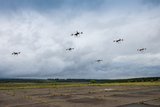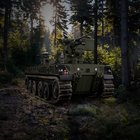AUVSI: PCAS reaches first design review
DARPA’s Persistent Close Air Support (PCAS) programme has completed its first Conceptual Design Review with mission systems integrator Raytheon describing aspirations for a ‘cross-service’ capability for current and future manned and unmanned air frames.
Speaking to Shephard ahead of the Unmanned Systems North America exposition in Washington, DC, Raytheon officials said findings from a series of trade studies had made PCAS relevant to marines, soldiers, sailors and airmen.
In April, Raytheon and Northrop Grumman were awarded $7m contracts by DARPA to develop the next-generation of Joint Terminal Attack Controller (JTAC) equipment and CONOPS relating to airborne sensors and weapons. The four-year programme includes an 18-month lead up to a Preliminary Design Review including a Systems Requirement Review scheduled for September ahead of a Phase 2-3 Programme Review in June 2012.
DARPA is then expected to down-select either Northrop Grumman or Raytheon to continue with the second phase in October 2012. The programme will use an unmanned A-10 Thunderbolt II or ‘Warthog’ for the demonstration in 2015.
However, it is envisaged that PCAS will be relevant to the USAF’s MQ-X next-generation UAV, which would replace in-service MQ-1 and MQ-9 Predator and Reaper UAVs is scheduled for 2019, Bossert added.
‘We are in the midst of trade studies and have found a broad applicability beyond JTACs. For example, anybody in the field that needs to produce an effect, be they Joint Fires Observers (JFOs) or Forward Air Controllers (FACs). There is a cross-service applicability which requires flexibility in design,’ senior engineering fellow for unmanned systems at Raytheon, Dave Bossert told Shephard.
Stressing the importance of including legacy equipment, Raytheon told Shephard that it was considering all radio equipment used by dismounted troops including AN/PRC-117G, AN/PRC-152, AN/PRC-148 as well as Link 16 military tactical data exchange network.
In collaboration with Rockwell Collins, Raytheon is also considering various computers, laser rangefinders and angulation devices as well as a variety of power sources for mission profiles up to 36 hours.
Unable to comment on which particular units with the US armed forces it was dealing with, Bossert admitted: ‘We are talking to the army, JFO personnel and the whole close air support community. We have to develop open architecture to interface with existing and future systems such as the Gen 4 Litening Pod as used for F-15 and F-16s. We are not tied to specific platforms.’
Essentially, the programme is designed to decrease the timeline for CAS missions, Bossert explained. ‘It’s all about shared situation awareness. We want the JTAC to be able to understand what weapons are available on the UAS as well as their effect. He can cycle through each and see graphically its effects on the ground.
‘Targets will be digitally injected into the system and seen on a map and the UAS operator will see the weapon selected by the JTAC. Anybody can override ant any point,’ he continued. It is understood that DARPA is considering four munitions including the JDAM, Laser Maverick, 2.75-in rocket and gun.
More from Uncrewed Vehicles
-
![Ready for the race: Air separation drone swarms vs. air defence systems]()
Ready for the race: Air separation drone swarms vs. air defence systems
As the dynamics of aerial combat rapidly evolve, Chinese scientists have engineered a sophisticated air separation drone model that can fragment into up to six drones, each capable of executing distinct battlefield roles and challenging the efficacy of current anti-drone defences such as the UK’s Dragonfire laser system.
-
![Israel’s MALE UAVs ‘must adapt’ to Iranian-made air defences]()
Israel’s MALE UAVs ‘must adapt’ to Iranian-made air defences
Advancements in air defence technologies have begun to reshape aerial combat dynamics in the Middle East, as illustrated by recent events involving the Israeli Air Force and Hezbollah.
-
![Hundreds more UAS sent to Ukraine forces with thousands more on the way]()
Hundreds more UAS sent to Ukraine forces with thousands more on the way
Both sides of the Russia-Ukraine war have been using UAS for effective low-cost attacks, as well as impactful web and social media footage. Thousands more have now been committed to Ukrainian forces.
-
![AI and software companies selected for US Army Robotic Combat Vehicle subsystems]()
AI and software companies selected for US Army Robotic Combat Vehicle subsystems
The US Army has intentions to develop light, medium and heavy variants of the Robotic Combat Vehicle (RCV) as part of the branche’s Next Generation Combat Vehicle family.
-
![DroneShield to improve software of DroneSentry-X C-UAS system under new contract]()
DroneShield to improve software of DroneSentry-X C-UAS system under new contract
DroneSentry-X, a cross-vehicle compatible, automated 360° C-UAS detect and defeat device, can offer 360° awareness and protection using integrated sensors. According to its manufacturer, it is suitable for mobile operations, on-site surveillance and on-the-move missions.
-
![Ukraine takes delivery of new indigenous C-UAS systems]()
Ukraine takes delivery of new indigenous C-UAS systems
Funded by the country’s former president, the new C-UAS systems will be sent to the frontline where they have already been tested against Russian invading forces.


























